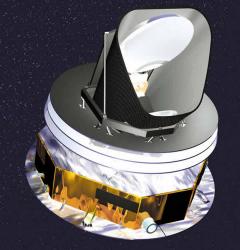 One of the most powerful new space observatories, ESA’s Planck mission, reached an important milestone with the integration of several instruments into the main satellite. The integration was performed by Alcatel Alenia Space in Cannes, France.
One of the most powerful new space observatories, ESA’s Planck mission, reached an important milestone with the integration of several instruments into the main satellite. The integration was performed by Alcatel Alenia Space in Cannes, France.
When it’s finally complete, Planck will use a 1.5 metre telescope to view the cosmic microwave background radiation. This is the afterglow of the radiation that filled the Universe after the Big Bang. Planck’s huge instrument and array of detectors will allow it to measure minute variations in this radiation, and help cosmologists understand the environment after the Big Bang. Not only that, but scientists will use Planck to understand the overall geometry of space, the density of normal matter versus dark matter, and the rate at which the Universe is accelerating apart. Important questions indeed.
In order to perform this science, Planck’s detectors will need to be cooled down to almost absolute zero (-270 degrees C). That’s because this background radiation is only 2.7 degrees above absolute zero.
The spacecraft is due to launch in July 2008.
Original Source: Jodrell Bank Observatory News Release
